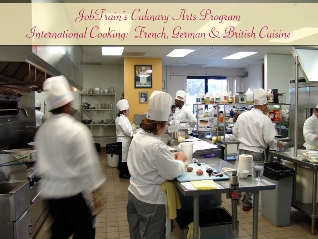50-Minute Classroom: Teaching International Cuisines
04 May 2010By Adam Weiner
 Is teaching a world of different cuisines possible in only 50 minutes? Probably not, says Chef Weiner, but international cuisines can be successfully taught in a short series of classes.
Is teaching a world of different cuisines possible in only 50 minutes? Probably not, says Chef Weiner, but international cuisines can be successfully taught in a short series of classes.
For most teachers, teaching international cuisines has two limitations: time and money.
Let’s be honest. I don’t think that you can teach international cuisines in only 50 minutes. But, I do think that you can teach international cuisines in a series of 50-minute classes. I would recommend allocating about five class periods for this.
Day 1: Give a brief presentation, accompanied by slides or pictures of different world cuisines. Don’t forget to explain that, like the United States, there are often major variations of cuisines within a country. Assign your students into groups and hand out a specific regional cuisine to each group. (I recommend that you assign the cuisines; otherwise the students will fall back on cuisines that they already know.) Tell the groups that their assignment will be to research the cuisines and make an oral presentation of the cuisine on Day 4. (The presentation should cover not only what dishes are common in that local cuisine, but also include a brief history of why the cuisine developed that way. On Day 5 the groups will prepare two dishes from the cuisine for everyone to taste.) On the first day, assign a homework project of looking at menus of local eateries that feature non-American cuisines as well as searching on the Web. I recommend that you give extra credit points for submitting copies of paper menus physically obtained from these eateries as part of the final report.
Day 2: Tell the groups that by the end of the period they have to give you a list of the ingredients they need to make their two dishes, but (to keep costs in check) they have to use standard ingredients normally used in your class. For example, bread flour is okay; rose water isn’t. The class time will be used to research their recipes and the materials needed for students’ oral presentations.
Day 3: Students are given the class period to work on their oral presentations and mise en place, if necessary.
Day 4: The groups make their oral presentations to the class.
Day 5: The groups make their dishes for the class.
The more groups you have, the more international cuisines you can cover. If you have more time. I suggest that instead of drawing out the five-day calendar, you do the project again with different groups and different cuisines. One variation is to do regional cuisines of the United States (e.g., Cajun/Creole, Southwest, California Nouvelle, Southern, New England, etc.) Of course, you can do this more than once in a class term.
One other variation is to combine international or regional cuisines with another culinary subject in your curriculum. For example, when teaching dumplings, you can have different groups prepare ravioli from Italy, pot stickers from China, piroshkies from Eastern Europe, etc. For teaching sautéing, you could use fajitas from Mexico, stir-frying from Asia or sautéed clams from Italy.
Chef Adam Weiner teaches a 20-week Introduction to Cooking program for JobTrain and the Sequoia Adult School on the San Francisco Peninsula.
Photo caption: Chef Adam Weiner teaches international cuisines successfully. In the home-page slide show, ravioli, such as these stuffed with an Italian cheese and presented with sausage in a stew, might be one way to teach different versions of dumplings around the world, with pot stickers from China and piroshkies from Eastern Europe being two others. Slide-show photo courtesy of Jones Dairy Farm.
